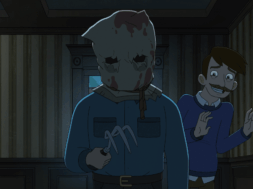Irish Slasher ‘Shrooms’ Shines By Experimenting With Horror Movie Tradition [Horrors Elsewhere]
Horrors Elsewhere is a recurring column that spotlights a variety of movies from all around the globe, particularly those not from the United States. Fears may not always be universal, but one thing is for sure — a scream is understood, always and everywhere.
Neither leprechauns nor banshees can be found in Paddy Breathnach’s Irish slasher Shrooms. Cinematic travelers instead see American tourists cross the Atlantic in search of magic mushrooms on the Emerald Isle. Their trip quickly goes from fun to bad, though, when a sinister local legend comes to fruition and one by one, the vacationers fall prey to the infamous Black Brother.
Shot in Monaghan, Armagh and Derry but set in Glengarriff, Shrooms is fully immersed in its bucolic and picturesque surroundings. The woodlands become a gray labyrinth where secrets are obscured by thick vegetation and shadows. The main characters find terror not only in their immediate dilemma but also themselves. Tara (Lindsey Haun) and her friends enter a remote Irish forest looking for a natural high; psilocybin mushrooms are in season. The group’s guide Jake (Jack Huston) instructs them to stay away from one specific shroom, yet as things always go in these movies, forbidden fruit never stays that way for long. One character’s mistaken ingestion, along with Jake’s persuasive campfire tale, sets things in motion.
Writer Pearse Elliott based his story on a real-life bad trip. The film is a mix of hallucinogenic horror and timeless slasher tropes, but it didn’t start out that way. By pursuing the psychological potential found in the original and more straightforward script — there was talk of having cannibals at one point — Breathnach helped distinguish the movie from others like it. Despite the director having always wanted to do horror, he was only offered comedies until Shrooms. His first outing in the genre is teeming with vistas courtesy of Nanu Segal, whose D.P. work stands out in Donkey Punch and The Children, and borrowings from Asian horror like Hideo Nakata’s Ring. Breathnach drew from those films’ tapered sense of humor and distinctive imagery including the skittering, phantom-like movements of the villain, scenes involving water, and prehensile hair.
It appears unusual for an Irish movie to feature a predominantly American cast, but this foreign element heightens the already unshakable uncertainty anyone might feel in a new and faraway place. And with this being a slasher about young people dying in the woods, it only makes sense for the cast to be full of established horror archetypes; Bluto (Robert Hoffman) is the aggressive jock; Lisa (Maya Hazen) is the uninhibited “mean girl;” Troy (Max Kasch) is the easygoing stoner while girlfriend Holly (Alice Greczyn) is an animal-loving free spirit. As always, it never makes sense how people with such disparate personalities become friends, yet their infighting paves the way for drama and later, carnage.
Then there is Tara, Shrooms’ central character whose innate virtue is crucial to the movie’s denouement. What undoubtedly becomes the film’s throughline is the idea of what might happen if someone completely released their inhibitions with a little help from Mother Earth. Tara fits the “final girl” role to a T; she’s inexperienced and a bit moralizing, not to mention fairly conservative as a result of her religious upbringing. She’s thoughtful of others and looks after people. Her less prim best friend Lisa teases her about eventually marrying a Catholic boy, but it’s obvious Tara has fuzzy feelings for the group’s shroom guide and her long-distance friend, Jake. Addressing those emotions, however, proves difficult for someone with her apprehension and system of beliefs.
Bypassing Ireland’s inherent and rich mythology for something more mundane like a bloodthirsty maniac may seem like a missed opportunity, but the delocalization makes Shrooms all the more accessible, as well as somewhat plausible. Huston’s character frightens the others with a rural legend concerning Glengarriff House, a place where underage boys were sent when they committed crimes. The home was run by a religious order of men known as the Black Knights of Colmcille, and among them was one particularly sadistic member who lived to torture. As retribution for killing his twin and scarring his own face, a boy dubbed “The Lonely Twin” secretly fed his abuser death mushrooms. This plan backfired because the Black Brother turned even more violent and acted on every pent-up desire; the result was a 78-body massacre where the only survivors, the Lonely Twin and the Black Brother, were left unaccounted for.
With 2000s horror being so trained to drop giant plot twists on the way out, it should be of no surprise Shrooms jumped on the bandwagon. Breathnach and Elliott’s own cunning upheaval defies slasher decorum and does the unthinkable. Those who have seen the film are likely split on the colossal revelation; the ultimate conclusion can be seen as a wrong move that betrays the audience. Looking back, the movie hinted at things to come. An unfortunate coincidence for all involved, Tara’s life parallels themes in Jake’s ghost story. She mentions earlier she was always afraid her father would send her away to a place like Glengarriff House after her mother died. It’s a neglected but important comment seeing as the home was made for misbehaving children — are viewers supposed to assume Tara’s restraint and piety are hiding something menacing? What viewers believe are premonitions of her friends’ deaths, caused by the verboten deathcaps, are really Tara manifesting her own subdued feelings and yearnings. It’s a crafty turn of events pulled off only because of Haun’s convincing performance.
Not a lot of rural slasher movies are as eye-catching as this one; it features one of the best nature tours in horror. The story ventures into the same neck of the woods as past films while still switching things up where it truly counts. However one might feel about the big reveal, they can’t dispute its intended shock value even if it doesn’t hold up in repeated viewings. The decade accused of lowest-denominator scares and excessive remaking was also an incredible time for international horror. Shrooms came and went without much fuss, but with all the turnaround happening for 2000s horror, it may be time to appreciate the movie’s ability to experiment with tradition.













